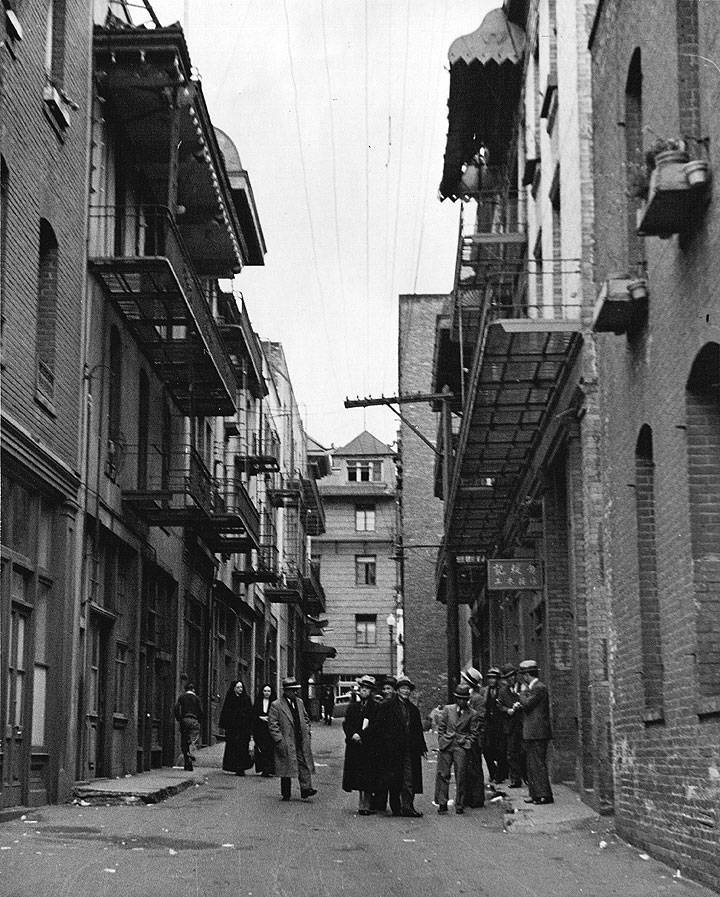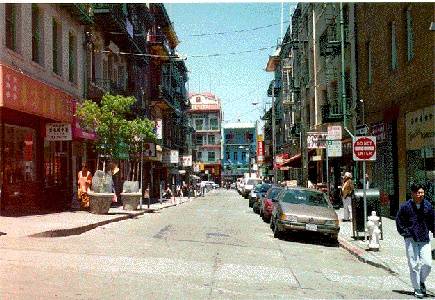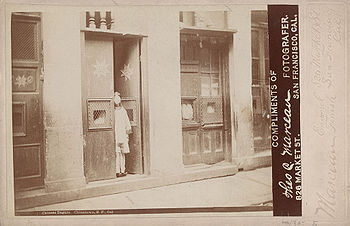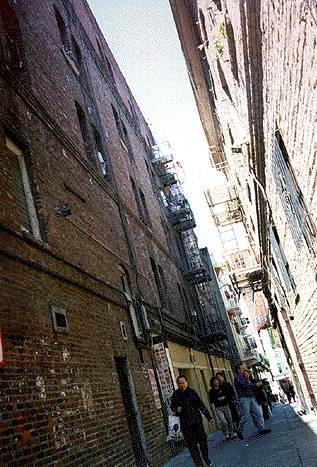Alleys of Ill-Repute: Difference between revisions
No edit summary |
No edit summary |
||
| (9 intermediate revisions by 4 users not shown) | |||
| Line 1: | Line 1: | ||
'''<font face = arial light> <font color = maroon> <font size = 3>Unfinished History</font></font> </font>''' | |||
[[Image:Chinatown-alley-1950s-courtesy-Jimmie-Shein.jpg]] | |||
'''Chinatown alley, c. 1950s.''' | |||
''Photo: Courtesy Jimmie Shein'' | |||
[[Image:chinatwn$waverly-place-1994.jpg]] | [[Image:chinatwn$waverly-place-1994.jpg]] | ||
'''Waverly Place -- a Chinatown alley''' | '''Waverly Place -- a Chinatown alley''' | ||
Ross Alley and Waverly Place | ''Photo: Brett Reierson'' | ||
Ross Alley and Waverly Place were the zones where "parlor houses," elite bordellos specializing in [[Sex Slaves for Sale or Rent|Chinese sex slaves]], flourished in the late 19th and early 20th centuries. Decked out in teakwood paneling and stocked with hand-embroidered silk cushions, colorful hangings, and plush couches, these establishments featured the most beautiful and well-trained girls culled from the yellow slave trade. The resident courtesans cost as much as a dollar, at a time when their lower-class competitors in the cribs could be had for twenty-five to fifty cents. | |||
Men slavers usually managed parlor houses along with gambling or opium dens, but occasionally courtesans who had bought their own freedom set up elite establishments ... White men or middle-class Chinese patronized most of the parlor houses, for wealthy Chinese would own several wives or slave girls. | Men slavers usually managed parlor houses along with gambling or opium dens, but occasionally courtesans who had bought their own freedom set up elite establishments ... White men or middle-class Chinese patronized most of the parlor houses, for wealthy Chinese would own several wives or slave girls. | ||
| Line 10: | Line 20: | ||
''--Dr. Weirde'' | ''--Dr. Weirde'' | ||
[[File:SanFranciscoChinatownBrothel.jpg|350px|thumb|right|Circa 1900 photograph by Theo C. Marceau showing Chinatown brothel or "bagnio"]] | |||
[[Image:chinatwn$ross-alley-1995.jpg]] | [[Image:chinatwn$ross-alley-1995.jpg]] | ||
| Line 15: | Line 27: | ||
'''Ross Alley today''' | '''Ross Alley today''' | ||
''Photo: Chris Carlsson'' | |||
''Carlsson | |||
[[Chinatown Vice | Prev. Document]] [[Donaldina Cameron House | Next Document]] | |||
[[ | [[category:Chinatown]] [[category:1880s]] [[category:1990s]] [[category:crime]] [[category:women]] | ||
Latest revision as of 22:39, 31 July 2012
Unfinished History
Chinatown alley, c. 1950s.
Photo: Courtesy Jimmie Shein
Waverly Place -- a Chinatown alley
Photo: Brett Reierson
Ross Alley and Waverly Place were the zones where "parlor houses," elite bordellos specializing in Chinese sex slaves, flourished in the late 19th and early 20th centuries. Decked out in teakwood paneling and stocked with hand-embroidered silk cushions, colorful hangings, and plush couches, these establishments featured the most beautiful and well-trained girls culled from the yellow slave trade. The resident courtesans cost as much as a dollar, at a time when their lower-class competitors in the cribs could be had for twenty-five to fifty cents.
Men slavers usually managed parlor houses along with gambling or opium dens, but occasionally courtesans who had bought their own freedom set up elite establishments ... White men or middle-class Chinese patronized most of the parlor houses, for wealthy Chinese would own several wives or slave girls.
Though they ate well and lived in sumptuous surroundings, the girls' life expectancies were short in that pre-penicillin era.
--Dr. Weirde
Ross Alley today
Photo: Chris Carlsson




